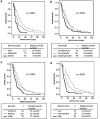A nuclear grading system is a strong predictor of survival in epitheloid diffuse malignant pleural mesothelioma
- PMID: 21983936
- PMCID: PMC4080411
- DOI: 10.1038/modpathol.2011.146
A nuclear grading system is a strong predictor of survival in epitheloid diffuse malignant pleural mesothelioma
Abstract
Epithelioid mesothelioma is the most prevalent subtype of diffuse malignant pleural mesothelioma in which only staging is prognostic for survival. In this study of epithelioid diffuse malignant pleural mesothelioma, we investigate the prognostic utility of nuclear features. The slides of 232 epithelioid diffuse malignant pleural mesothelioma patients (14 stage I, 54 stage II, 130 stage III, and 34 stage IV) from a single institution were reviewed for the following seven nuclear features: nuclear atypia, nuclear/cytoplasmic ratio, chromatin pattern, intranuclear inclusions, prominence of nucleoli, mitotic count, and atypical mitoses. MIB-1 immunohistochemistry was performed using tissue microarray, and MIB-1 labeling index was recorded as the percentage of positive tumor cells. Median overall survival of all patients was 16 months and correlated with nuclear atypia (P<0.001), chromatin pattern (P=0.031), prominence of nucleoli (P<0.001), mitotic count (P<0.001), and atypical mitoses (P<0.001) by univariate analysis. Multivariate analysis revealed nuclear atypia (P=0.012) and mitotic count (P<0.001) as independent prognostic factors, and these two factors were utilized to create a three-tier nuclear grade score. The resulting nuclear grade stratified patients into three distinct prognostic groups: grade I (n=107, median overall survival=28 months), grade II (n=91, 14 months), and grade III (n=34, 5 months). Not only was nuclear grade an independent predictor of overall survival (P<0.001), but it was also a stronger discriminator of survival than all currently available factors. Furthermore, nuclear grade was associated with time to recurrence (P=0.004) in patients who underwent complete surgical resection (n=159). MIB-1 labeling index correlated with mitotic count (P<0.001) and nuclear atypia (P=0.037) and stratified overall survival (P<0.001) and time to recurrence (P=0.048), confirming the prognostic value of the nuclear grade. Nuclear grading in epithelioid mesothelioma provides a simple, practical, and cost-effective prognostic tool that better stratifies clinical outcome and time to recurrence than currently available clinicopathologic factors.
Conflict of interest statement
The authors declare no conflict of interest.
Figures





References
-
- Churg A, Cagle PT, Roggli VL. Tumors of the Serosal Membranes. Series IV. American Registry of Pathology; Washington DC: 2006. pp. 33–72.
-
- Robinson BWS, Lake RA. Advances in malignant mesothelioma. N Engl J Med. 2005;353:1591–1603. - PubMed
-
- Sugarbaker DJ, Flores RM, Jaklitsch MT, et al. Resection margins, extrapleural nodal status, and cell type determine postoperative long-term survival in trimodality therapy of malignant pleural mesothelioma: results of 183 patients. J Thorac Cardiovasc Surg. 1999;117:54–65. - PubMed
-
- Rusch VW, Venkatraman ES. Important prognostic factors in patients with malignant pleural mesothelioma, managed surgically. Ann Thorac Surg. 1999;68:1799–1804. - PubMed
-
- Flores RM, Zakowski M, Venkatraman E, et al. Prognostic factors in the treatment of malignant pleural mesothelioma at a large tertiary referral center. J Thorac Oncol. 2007;2:957–965. - PubMed
Publication types
MeSH terms
Substances
Grants and funding
LinkOut - more resources
Full Text Sources
Medical

